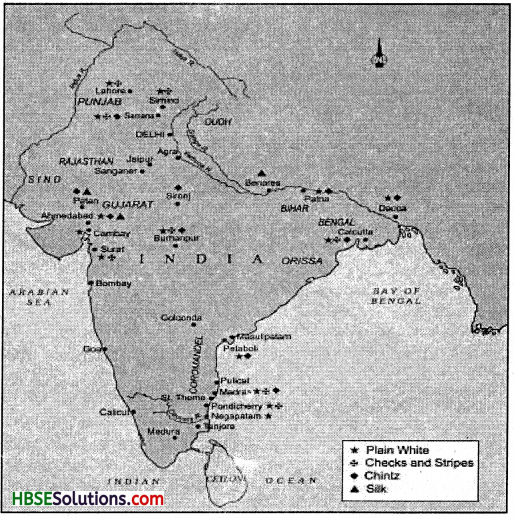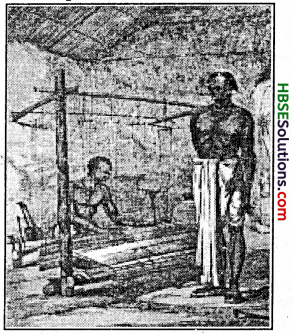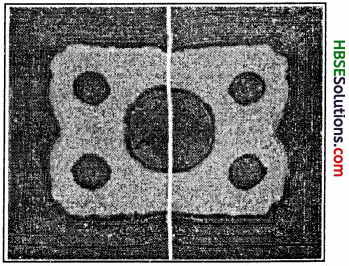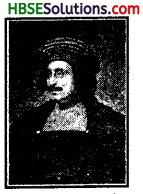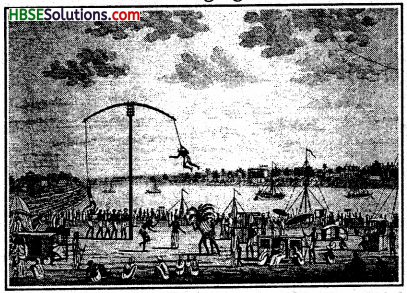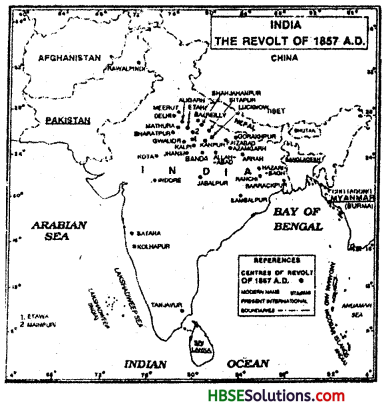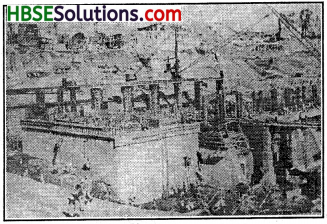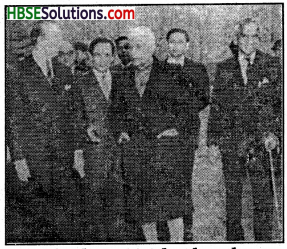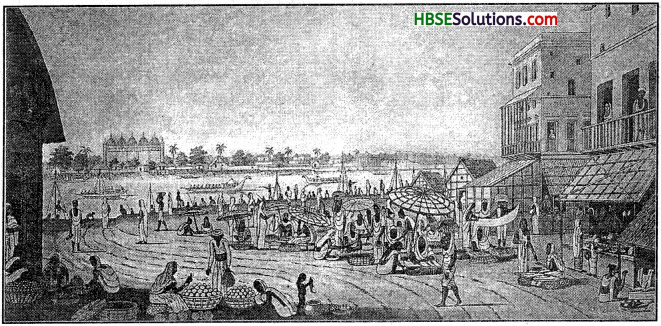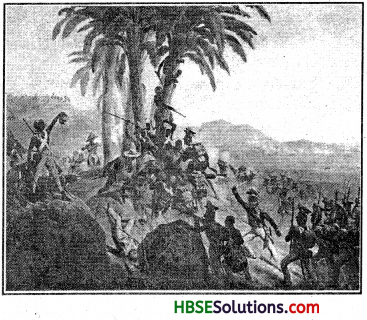Haryana State Board HBSE 8th Class Social Science Solutions History Chapter 6 Colonialism and the City: The Story of an Imperial Capital Textbook Exercise Questions and Answers.
Haryana Board 8th Class Social Science Solutions History Chapter 6 Colonialism and the City: The Story of an Imperial Capital
HBSE 8th Class History Colonialism and the City: The Story of an Imperial Capital Textbook Questions and Answers
LETS RECALL
Question 1.
State whether true or false :
(a) In the Western world, modern cities grew with industrialisation.
(b) Surat and Machlipatnam developed in the nineteenth century.
(c) In the twentieth century, the majority of Indians lived in cities.
(d) After 1857 no worship was allowed in the Jama Masjid for five years.
(e) More money was spent on cleaning Old Delhi than New Delhi.
Answer:
(a) True
(b) False
(c) False
(d) True
(c) False.
Question 2.
Fill in the blanks:
(a) The first structure to successfully use the dome was called the __________.
(b) The two architects who designed New Delhi and Shahjahanabad were __________ and __________.
(c) The British saw overcrowded spaces as __________.
(d) In 1888 an extension scheme called the __________ was devised.
Answer:
(a) minar
(b) Edward Lutyens, Henry Baker
(c) black areas
(d) Lahore Gate Improvement Scheme

Question 3.
Identify three differences in the city design of New Delhi and Shahjahanabad.
Answer:
| Shahjahanabad |
New Delhi |
| (a) Shahjahanabad (begun in 1639) was constructed as a fort palace complex and the city adjoining it. |
(a) New Delhi was built by the British in twentieth century on a modern planning and pattern. |
| (b) There were 14 gates of entry into the city. Some of them still stand are: Lahori Gate, Delhi Gate, Ajmeri Gate, Kashmiri Gate. The main streets of Chandni Chowk and Faiz Bazaar were broad enough for royal processions to pass. There were densely packed mohallas and several dozen bazaars. Jama Masjid was among the largest and grandest mosques in India. |
(b) New Delhi was a very clean city. The new city had broad roads, big bungalows and many gardens. It had improved drainage system.
New Delhi represents a sense of law and order in contrast to the chaos of Old Delhi. |
| (c) Shahjahanabad was confined to the walls built by Shah Jahan. The old culture was based on Urdu. |
(c) The area around Red Fort was cleared in New Delhi. The culture of Urdu was replaced by Punjabi culture. |
Question 4.
Who lived in the “White” areas in cities such as Madras?
Answer:
British and Europeans lived in the “White” areas in cities (Bombay and Calcutta also) such as Madras (now Chennai).
LETS DISCUSS
Question 5.
What is meant by de-urbanisation?
Answer:
Decline and decay of the cities is called deurbanisation. For example, in the late eighteenth century, many towns manufacturing specialised goods declined due to a drop in the demand for what they produced. Also, earlier centres of regional power collapsed when local rulers were defeated by the British and new centres of administration emerged.
Question 6.
Why did the British choose to hold a grand Durbar in Delhi although it was not the capital?
Answer:
Following causes were responsible to choose by the British to hold a grand Durbar in Delhi although it was not the capital of the British India:
(a) The British were fully aware of the symbolic importance of Delhi. During the Revolt of 1857, the British had realised that the Mughal emperor was still important to the people and they saw him as their leader. It was, therefore, important to celebrate British power with pomp and show in the city, the Mughal emperors had earlier ruled.
(b) In 1911, when King George V was crowned in England, a Durbar was held in Delhi to celebrate the occasion. The decision to shift the capital of India from Calcutta to Delhi was announced at this Durbar.

Question 7.
How did the Old City of Delhi change under British rule?
Answer:
- Delhi was captured by the British in 1803 after defeating the Marathas. The modern city of Delhi developed after 1911, when it became the capital of British India. .
- When the British recaptured Delhi in September 1857, they ravaged and plundered the whole city.
- The area around the Red Fort was, completely cleared for security purpose.
- The gardens of the royal palace were shut down.
- Several places were razed and barracks were built in their place for the British troops to stay.
- The Zinat-al-Masjid was converted into a bakery.
- One-third of the monuments in Delhi were demolished and the canals were filled up.
- Railway tracks were laid down, and thus, the city expanded beyond the huge walls.
Question 8.
How did the partition affect life in Delhi?
Answer:
The following changes could be seen in Delhi after Partition:
(i) As a result of Partition of India in 1947, there was a mass transfer of people from both India and Pakistan. It resulted in an increase in population of Delhi, change of job and culture of the city and its people.
(ii) The riots followed the partition, thousands of people in Delhi were killed, their homes looted and burned.
(iii) The refugees who came from Pakistan occupied the empty houses of Shahjahanabad. Many refugees came to Delhi from Punjab.
(iv) As most of the migrants were from Punjab, the Urdu based culture of Delhi was replaced by the new culture of Punjab and other native places of migrants.
(v) New shops and stalls were set-up to meet the demands. New colonies of Lajpat Nagar and Tilak Nagar were formed at this time.
(vi) Old Delhi also witnessed the extinction of Havelis.

LETS DO
Question 9.
Find out the history of the town you live in or any town nearby. Check when and how it grew, and how it has changed over the years. You could look at the history of the bazaars, the buildings, cultural institutions and settlements.
Answer:
I am Shivaji Dhawle. I am living in Mumbai (previously called Bombay). I am giving the brief history and stages of its development below:
Architecture in Bombay:
(а) Joining of islands: Bombay was initially seven islands. As the population grew, the island were joined to create more space and the gradually changed into one big city. Bombay was the commercial capital of colonial India. As the premier part on the western coast it was the centre of international trade.
(b) As Bombay’s economy grew, from the mid¬nineteenth century there was a need to expand railways and shipping and develop the administrative structure. Many new buildings, were constructed at this time. These buildings reflected the culture and confidence of the rulers.
(c) As a trade centre : By the end of the nineteenth century, half the imports and exports of India passed through Bombay. One important item of this trade was opium that the East India Company exported to China. Indian merchants and middlemen supplied and participated in this trade and they helped integrate.
(d) Bombay’s economy directly to Malwa, Rajasthan and Sind where opium was grown. This collaboration with the Company was profitable and led to the growth of an Indian capitalist class. Bombay’s capitalists came from diverse communities such as Parsi, Marwari, Konkani Muslim, Gujarati Bania, Bohra, Jew and Armenian.
(e) Style of Architecture of Buildings : The architectural style was usually European. This importation of European styles reflected the imperial vision in several ways. First, it expressed the British desire to create a familiar landscape in an alien country, and thus to feel at home in the colony. Second, the British felt that European styles would best symbolise their superiority, authority and power.
(f) Initially, these buildings were at odds with the traditional Indian buildings. Gradually, Indians too got used to European architecture and made it their own. The British in turn adapted some Indian styles to suit their needs.
(g) For public buildings three broad architectural styles were used. Two of these were direct imports from fashions prevalent in England. The first was called neo-classical or the new classical. Its characteristics included construction of geometrical structures fronted with lofty pillars. It was derived from a style that was originally typical of buildings in ancient Rome.
(h) Another style that was extensively used was the neo-Gothic, characterised by high-pitched roofs, pointed arches and detailed decoration. The Gothic style had its roots in buildings, especially churches, build in northern Europe during the medieval period. Indians gave money for some of these buildings. The University Hall was made with money donated by Sir Cowasjee Jehangir, a rich Parsi merchant.
(i) Towards the beginning of the twentieth century, a new hybrid architectural style developed which combined the Indian with the European. This was called Indo-Saracenic. “Indo” was shorthand for Hindu and “Saracen” was a term European used to designate Muslim.
(j) In the more “Indian” localities of Bombay traditional styles of decoration and building predominated. The lack of space in the city and crowding led to a type of building unique to Bombay, the chawl, the multi-storeyed single-room apartments with long open corridors built around a courtyard. v.
Or
I am S. Karunanidhi. I am living at Chennai (previously called Madras). A brief history of it and stages of development are given below:
(a) Coming of the English on East Coast: The Company had first set up its trading activities in the well-established port of Surat on the west coast. Subsequently the search for textiles brought British merchants to the east coast.
(b) Purchase of land for city of Madras: In 1639 they constructed a trading post in Madraspatam. This settlement was locally known as Chenapattanam. The Company had purchased the right of settlement from the local Telugu lords, the Nayaks of Kalahasti, who were eager to support trading activity in the region.
(c) Fortification of Madras and its results: Rivalry (1746-63) with the French East India Company led the British to fortify Madras and give their representatives increased political and administrative functions. With the defeat of the French in 1761, Madras become more secure and began to grow into an important commercial town. It was here that the superiority of the British and the subordinate position of the Indian merchants was most apparent.
(d) White Towns within Madras : Fort St. George became the nucleus of the White Town where most of the Europeans lived. Walls and bastions made this a distinct enclave. Colour and religion determined who was allowed to live within the fort. The Company did not permit any marriages with IndiAnswer: Other than the English, the Dutch and Portuguese were allowed to stay here because they were European and ChristiAnswer: The administrative and the judicial systems also favoured the white population. Despite being few in number the Europeans were the rulers and the development of Madras followed the needs and convenience of the minority whites in the town.
(e) Black Towns within Madras : The Black Town developed outside the Fort. It was laid out in straight lines, a characteristic of colonial towns. It was, however, demolished in the mid-1700s and the area was cleared for a security zone around the Fort. A new Black Town developed further to the north. This housed weavers, artisans, middlemen and interpreters who played a vital role in the Company’s trade.
(f) Collection of taxtation and information : For a long while they were suspicious of census operations and believed that enquiries were being conducted to impose new taxes. Upper-caste people were also unwilling to give any information regarding the women of their household. Women were supposed to remain secluded within the interior of the household and not subjected to public gaze or public enquiry.
(g) Wrong information of census officials by the hawkers and small traders: Census officials also found that people were claiming identities that they associated with higher status. For instance there were people in towns who were hawkers and went selling small articles during some seasons, while in other seasons they earned their livelihood through manual labour. Such people often told the census enumerators that they were traders, not labourers, for they regarded trade as a more respectable activity.
(h) Wrong information regarding death and illness: Similarly, the figures of mortality and disease were difficult to collect, for all deaths were not registered, and illness was not always reported, nor treated by licensed doctors. How then could cases of illness or death be accurately calculated?

Question 10.
Make a list of at least ten occupations in the city, town or village to which you belong, and find out how long they have existed. What does this tell you about the change within this area?
Answer:
List of ten occupations of a village or town:
- Agriculture
- Carpentry
- Jewellery-making
- Teaching
- Medicine and surgery
- Rearing of animals
- Blacksmith
- Trade
- Textile-designing
- Interior- decoration.
(а) Agriculture : Agriculture is the oldest occupation in the villages. The farming methods have been changed from traditional to modern. The new and improved irrigation methods, use of manures, fertilizers have been introduced.
(b) Wood-work : The latest tools, implements and machines are being used which has improved the standard of living of carpenters.
(c) Jewellery-making: Though the people have been using jewellery since ancient times, there have been drastic changes in the designs of jewellery.
(d) Teaching: The latest methods of teaching with the use of computers, CDs are being used.
(e) Medicine and surgery : Though, the patients are being treated since old, there have been advancements in this field which has reduced the death rate.
(f) Rearing of animals : The dairy farms have been developed which have electric- fittings for cattle provide them facilities.
(g) Blacksmith : With the help of latest technology, all types of grills, windows, iron-rods are being prepared, according to the needs of customers.
(h) Trade : Traders are using greater use of services like banking, transport and modern methods of business management.
(i) Textile-designing: From the traditional methods of weaving and spinning the latest methods of machine looms have increased both the quantity and quality of textile.
(j) Interior-decoration : This is the emerging field in the area of occupations. The houses are designed in still manner taking care of safety measures.
LETS IMAGINE
Imagine that you are a young man living in Shahjahanabad in 1700. Based on the description of the area in this chapter write an account of your activities during one day of your life.
Answer:
I am directed to suppose and to do the writing work as instructed in the activity work – Let’s imagine. I am a youngman of twenty years, living in Shahjahanabad in 1700.
1. Aurangzeb is our Emperor. Shahjahanabad is the capital town of the Mughal empire. It is also a trade centre.
2. I used to go to Jama Masjid daily to offer my prayer to Allah, at least two times a day. I had to go to colourful world of poetry and dance alone because it was allowed only by men. Women are not allowed to visit colourful world of poetry and dance. I had to avoid celebrations and processions because generally these led to serious conflicts. I generally enjoy Urdu/ Persian culture and poetry and participated in local festivals. I used to go five times daily to offer Namaz in Jama Masjid.
As a resident of the old city, we use to get fresh drinking water to our homes. There is an excellent drainage system also. I live in a haveli, which housed many families.
HBSE 8th Class History Colonialism and the City: The Story of an Imperial Capital Important Questions and Answers
Very Short Answer Type Questions
Question 1.
How did the famous poet Ghalib describe the ransacking of Delhi in 1857 ?
Answer:
Ghalib said “when the angry lions (the British) entered the town, they killed the helpless and burned houses. Hordes, of men and women, commoners and noblemen, poured out of Delhi from the three gates and took shelters in small communities and tombs outside the city.”
Question 2.
What is an imperial capital?
Answer:
Political centre (or capital) used as a central point of political activities, administration and control by any imperial power (or country) is called imperial capital. For example, (Approx, from 1757 to 1911) Calcutta was imperial capital of British India. Delhi was made imperial capital after the Royal Durbar of 1911.

Question 3.
What happened to the Delhi College in 1877?
Answer:
The Delhi College was turned into a school and shut down in 1877.
Question 4.
When was the decision to shift the capital of India from Calcutta to Delhi announced?
Answer:
The decision to shift the capital of India from Calcutta to Delhi was announced in 1911.
Question 5.
Why did the importance of Machli- patnam decline in the 17th century?
Answer:
Machlipatnam developed as an important town in the 17th century. Its importance declined by the.late 18th century as trade shifted to the new British ports of Bom bay, Madras and Calcutta.
Question 6.
What were ‘Havelis’?
Answer:
The grand mansions where the Mughal aristocracy lived in the seventeenth and eighteenth centuries were called Havelis.
Question 7.
Why did ‘Havelis’ begin to decline?
Answer:
Many of the Mughal amirs were unable to maintain.
Question 8.
Name the three presidency cities of India.
Answer:
Calcutta, Bombay and Madras.
Question 9.
When did the British gain control of Delhi?
Answer:
The Britsh gained control of Delhi in 1803 after defeating the Marathas.
Question 10.
When was Delhi made the Capital of India?
Answer:
In 1911.
Question 11.
Why were the western walls of Shahjahanabad broken in 1870s?
Answer:
To establish the railway and to allow the city of expand beyond the walls.
Question 12.
What was the design of streets in the Lahore Gate improvement scheme?
Answer:
The streets followed the grid pattern and were of identical width, size and character.
Question 13.
When was the Delhi improvement trust set-up?
Answer:
In 1936.

Question 14.
What did the British do to make Delhi forget the Mughal past?
Answer:
They completely cleaned the area around the fort – Gardens, pavilions, mosques were either demolished or used for other purpose.
Short Answer Type Questions
Question 1.
What steps were taken by British so that Delhi forgets its Mughal Past?
Answer:
The following steps were taken by the British so that Delhi forgets its Mughal Past:
(a) The area around the Fort was completely cleared of gardens, pavilions and mosques.
(b) Mosques were either destroyed or put to other uses. For instance, the Zinat- al-Masjid was converted into a bakery.
(c) No worship was allowed in Jama Masjid for five years.
Question 2.
How many ‘Delhis’ were there before New Delhi? What were its features related with common political role and geographical location?
Answer:
(a) Delhi has been a capital for more than a 1000 years, although with some gaps.
(b) As many as 14 capital cities were founded in a small area of about 60 square miles on the left bank of the river Jamuna (or Yamuna).
(c) The remaining of all other capital may be seen on a visit to modern city state of Delhi.
(d) The most splendid capital of all was built by the great Mughal Emperor Shah Jahan. Shahjahanabad was constructed in 1639. It consisted of a fort-palace (Red Fort) complex and the city adjoining.
Question 3.
Write three positive features of Shahjahanabad or Old Delhi.
Answer:
Shahjahanabad was the most splendid capital whose construction began in 1639. Its positive features were :
(а) The main streets of Chandni Chowk and Faiz Bazaar were broad enough for royal processions to pass.
(b) It was also an important centre of Sufi culture. It had several dargahs, khanqahs and idgahs.
(c) Open squares, winding lanes, quiet cul- de-sacs and water channels were the pride of Delhi’s residents. No wonder the poet Mir Taqi Mir said, “The streets of Delhi aren’t mere streets : they are like the album of a painter.”
Question 4.
What were the negative features of living-style in Old Delhi?
Answer:
The following were the negative features of living-style in Old Delhi :
(a) Old Delhi was no ideal city and its delights were enjoyed only by some. There were sharp division between rich and poor.
(b) Havelis or mansions were interspersed with the far more numerous mud houses for the poor.
(c) The colourful world of poetry and dance was usually enjoyed only by men.
(d) Celebrations and processions often led to serious conflicts.
Question 5.
What was the idea behind the extension scheme called the Lahore Gate Improvement Scheme ?
Answer:
Lahore Gate improvement scheme was planned by Robert Clarke which pMnned:
- To draw residents away from the Old City to a new type of market square around which shops would be built.
- Streets in this redevelopment strictly followed the grid pattern, and were of identical width, size and character.
- Land was divided into regular areas for the construction of neighbourhoods.

Long Answer Type Questions
Question 1.
What were the features of the new urban centres built by the British?
Answer:
- Many of the new urban centres like Calcutta and Madras developed around forts.
- The new cities had broad roads and large and imposing public buildings like government offices, public libraries, museum and town halls.
- Most of the British in India lived outside the old walled town where the Indians lived. The areas where the
- Indians lived were generally crowded and conditions were often unhygienic.
- The part of the city where the British lived was generally divided into the civil lines and the military cantonment.
Question 2.
What were the main features of the colonial bungalow?
Answer:
- It was a large single-storeyed structure with a pitched-roof, and usually set in one or two areas of open ground.
- It had separate living and dining rooms and bedrooms.
- It had a wide veranda running in the front, and sometimes on three sides.
- Kitchens, stables and servants quarters were in separate apace from the main house.
- The house was run by dozens of servants.
- The women of the household often sat on the verandas to supervise tailors or other tradesmen.
Question 3.
Discuss the features of new buildings made by the British in New Delhi.
Answer:
(i) The features of these buildings were borrowed from different periods of India’s imperial history. But, the overall look of these government buildings was like classical Greece.
(ii) The central dome of the Viceroy’s palace was copied from the Buddhist Stupa at Sanchi.
(iii) The red sandstones and carved screens of Jalis were borrowed from Mughal architecture.
(iv) The assert the British importance, the Viceroy’s palace was built at a place higher than that of Shah Jahan’s Jama Masjid.

Question 4.
Discuss the features of colonial bungalow.
Answer:
- These bungalows were meant for one nuclear family.
- The colonial bungalow was a large single storeyed structure usually set in one or two acres of open ground.
- It had separate living rooms, diningrooms and bedrooms.
- It had a wide veranda running in the front and sometimes on three sides.
- Kitchens, stables and servant’s quarters were in a separate space from the main house.
Source-Based Questions
Source 1
“Dillijo ek shahr tha alam mein intikhab… ”
By 1739, Delhi had been sacked by Nadir Shah and plundered many times. Expressing the sorrow of those who witnessed the decline of the city, the eighteenth-century Urdu poet Mir Taqi Mir, said :
Dilli jo ek shahr tha alam mein intikhab,… Ham rahnewale hain usi ujre dayar ke (7 belong to the same ruined territory of Delhi, which was once a supreme city in the world)
Read the source given above and answer the following questions:
Question 1.
Who was Nadir Shah ? Who was the Mughal ruler when he plundered Delhi?
Answer:
Nadir Shah was an invader, who attacked India and its capital Delhi in 1739. He plundered Hindustan and Delhi for many days. At that time Mohammad Shah was the Mughal ruler.
Question 2.
How did the poet express his sorrow about the imperial capital of India?
Answer:
Poet Mir Taqi Mir said that we are living in the decayed, destroyed and declined city of India. No doubt once Delhi was a supreme city in the world, but it had been changed in ruins by Nadir Shah in 1739.
Source 2
“There was once a city of this name”
Ghalib lamented the changes that were occurring and wrote sadly about the past that was lost. He wrote :
What can I write? The life of Delhi depends on the Fort, Chandni Chowk, the daily gatherings at the Jamuna Bridge and the Annual Gulfaroshan. When all these … things are no longer there, how can Delhi live? Yes, there was once a city of this name in the dominions of India.
Read the source given above and answer the following questions:
Question 1.
What changes are talked about in the source above?
Answer:
The changes in the life of Delhi are talked about in the source.
Question 2.
Who has lamented such changes?
Answer:
Ghalib.
Question 3.
What is Gulfaroshan?
Answer:
A festival of flowers.

Question 4.
What tilings could no longer be seen in Delhi?
Answer:
The things like Chandni Chowk, the daily gatherings at the Jamuna Bridge, and the Annual Gulfaroshan could no longer be seen in Delhi.
Source 3
The vision of New Delhi This is how Viceroy Hardinge explained the choice of Delhi as capital :
The change would strike the imagination of the people of India …. and would be accepted by all as the assertion of an unfaltering determination to maintain British rule in India.
The architect Herbert Baker believed :
The New Capital must be the sculptural monument of the good government and unity which India, for the first time in its history, has enjoyed under British rule. British rule in India is not a mere veneer of government and culture. It is a new civilisation in growth, a blend of the best elements of East and West….
It is to this great fact that the architec-ture of Delhi should bear testimony.
(2 October 1912)
Read the source given above and answer the following questions:
Question 1.
Who believed that the choice of New Delhi as capital was a determin¬ation to maintain British rule in India?
Answer:
Viceroy Hardinge.
Question 2.
Who was architect of New Delhi?
Answer:
Herbert Baker.
Question 3.
Write the good points that the architect of New Delhi believed about it.
Answer:
(a) The New Delhi must be the creator of monument of the good government, i.e. the British Government in India.
(b) India would feel united as a nation, for the first time under the British rule.
Colonialism and the City: The Story of an Imperial Capital Class 8 HBSE Notes
- Presidency: For administrative purposes, colonial India was divided into three “Presidencies” (Bombay, Madras and Bengal), which developed from the East India Company’s “factories” (tradingposts) at Surat, Madras and Calcutta.
- Urbanisation : The process by which more and more people begin to reside in towns and cities.
- Dargah : The tomb of a Sufi saint.
- Khanqah : A sufi lodge, often used as a rest house for travellers and a place where people come to discuss spiritual matters, get the blessings of saints, and hear sufi music.
- Idgah : An open prayer place of Muslims primarily meant for Id prayers.
- Cul-de-sac : Street with a dead end.
- Gulfaroshan : A festival of flowers.
- Renaissance: Literally, rebirth of art and learning. It is a term often used to describe a time when there is a great creative activity.
- Amir : A nobleman.
![]()
![]()
![]()
![]()
